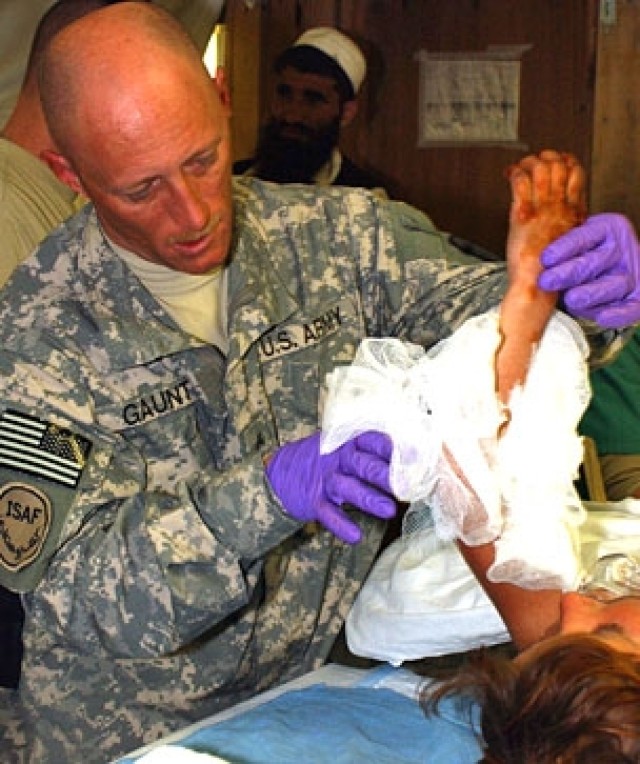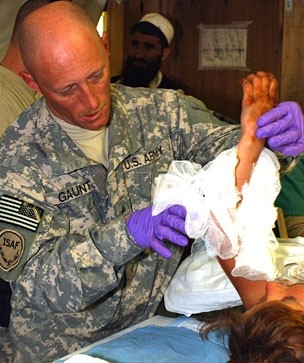FORWARD OPERATING BASE SALERNO, Afghanistan - An all too familiar call echoed through the Forward Operating Base Salerno burn clinic and medical staff and hospital volunteers scrambled to receive two young Afghan sisters badly burned in a heater explosion at their home.
The girls were rushed into the clinic by the medical and volunteer staff who quickly took steps to assess their condition and begin lifesaving procedures.
"We get children like this all the time," said Staff Sgt. Ronald Payne, the noncommissioned officer in charge of the department of emergency services with the 14th Combat Support Hospital. "A heater in their home had a malfunction and it exploded, burning all four of the children and burning down the entire house. Two of the children are fatalities and the other two survivors are here being treated."
The two sisters lay on a white table side-by-side with second and third degree burns covering their shivering bodies. The youngest, about four years old, had burns all over her face, head, arms and hands, and is in a desperate battle for her life.
Spc. Kristopher Weaver, a volunteer who works in the information management office with the 219th Area Support Group from the Indiana National Guard, prepared solution for cleaning her burns.
The hospital volunteers all have a different Mission Occupation Specialty and offer their assistance in any capacity needed by the hospital staff.
Assisting Weaver is Chief John Bailey, assistant base fire chief, who assumes the daunting task of scrubbing the child's burns in order to remove dead skin, allowing for good, live skin to begin pushing its way to the surface.
Bailey began volunteering regularly two months ago, along with six other firefighters from the FOB Salerno Fire Department. They come in on their days off to help out at the burn center. As a firefighter, he is accustomed to responding to medical emergencies, but he enjoys the experience working with the burn center gives him in addition to the change of working in the medical arena.
"We're the ones who pull people out of fires and this gives us a different view of what happens when we hand the patient over to medical personnel," said Bailey. "We see what the patient goes through, and being a part of the treatment process gives me a different outlook. My favorite part of volunteering is not seeing the patients anymore because they've gotten better and gone home."
The older sister, about six years old, sustained second degree burns on her chest, arms and legs. She is expected to recover but with continuous monitoring for prevention of infection and complications. She is being cared for by volunteer Army Staff Sgt. Dusty Gaunt, Noncommissioned Officer in Charge of the firing range as well as the Material Handling and Equipment NCO with the 219th ASG from the Indiana National Guard.
Gaunt carefully applied a topical ointment to the girl's burnt extremities which promotes healing and regeneration of the skin. He is a former emergency medical technician who enjoys volunteering so much he is considering going to nursing school when he returns home.
Patients who are admitted to FOB Salerno's burn center receive excellent care and a better than average recovery advantage.
"The recovery rate we have here at FOB Salerno rivals the rates of hospitals in the United States, which is very good," said Payne.
Much of the success of patient's recovery is due to the contributions of the volunteers who generously donate their time and energy to help casualties like the Afghan sisters.
"The area in need of help the most is the burn center which has been operational for about two months," said Maj. Elizabeth P. Vinson, head nurse with the 14th Combat Support Hospital.
Because Afghans use butane or fuel heaters to heat their homes in the winter months, accidents such as these are very common.
"Part of the problem is the fuel sold to many people is the wrong type and very unstable," said Sultan Ahmad, an Afghan Cultural Specialist, who works on the base. "They put this fuel in their heaters and go to light it and it explodes because it is mixed with gasoline. Every year, hundreds of people get burnt this way."
"At our height we had 14 patients being treated at the same time and had five crews of staff and volunteers tending to them," said Payne.
"But it's the volunteers who do all the major work. The volunteers are the real soldiers here," Payne added. "After a while these guys get so good at it they can run a table by themselves."
Successfully operating a burn center is not something that can be done single-handedly. It requires additional support from other agencies on the base that provide services the hospital can not.
"I have to thank the Kellogg Brown and Root dining facility workers. They have supported us tremendously," said Payne. "Burn victims use up a lot of calories and need protein to rebuild muscle. The food that helps them do this is provided by the DFAC which dramatically increases the rate of recovery."
Another factor is the number of Afghan doctors in Khost province who are learning treatment techniques and procedures from their American counterparts to care for burn victims.
"We are teaching them how to diagnose the different stages of burns, to remove harmful burn tissue, to diagnose and perform skin graphs and to conduct surgical intervention," said Vinson.
Three Afghan doctors who were taught at the burn center have done so well they have been selected to staff a new clinic. The new facility, the Brick Clinic, will be located just outside the FOB Salerno gate and will include a treatment center for burn victims.
"Teaching is extremely important. It is 70 percent of the entire mission," said Payne. "We have a shortage of staff and without volunteers we couldn't do what we do. We can expand the number of patients we see and it is the volunteers who allow us to do that. It is their hands doing the work."
Which begs the question, why work when you don't have to' Payne suggests that the reason rests in the desire most people have of being a part of something that matters.
"You are really making a difference in someone's life when what you're doing is meaningful" he said. "I think that is what keeps the volunteers coming back."


Social Sharing